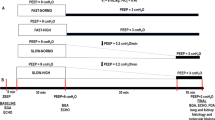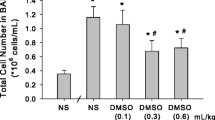Abstract
Acute respiratory distress syndrome (ARDS) is the most severe lung inflammatory manifestation and has no effective therapy nowadays. Sepsis is one of the main illnesses among ARDS causes. The use of fluid resuscitation is an important treatment for sepsis, but positive fluid balance may induce pulmonary injury. As an alternative, fluid resuscitation with hypertonic saline ((HS) NaCl 7.5 %) has been described as a promising therapeutical agent in sepsis-induced ARDS by the diminished amount of fluid necessary. Thus, we evaluated the effect of hypertonic saline in the treatment of LPS-induced ARDS. We found that hypertonic saline (NaCl 7.5 %) treatment in rat model of LPS-induced ARDS avoided pulmonary function worsening and inhibited type I collagen deposition. In addition, hypertonic saline prevented pulmonary injury by decreasing metalloproteinase 9 (MMP-9) activity in tissue. Focal adhesion kinase (FAK) activation was reduced in HS group as well as neutrophil infiltration, NOS2 expression and NO content. Our study shows that fluid resuscitation with hypertonic saline decreases the progression of LPS-induced ARDS due to inhibition of pulmonary remodeling that is observed when regular saline is used.








Similar content being viewed by others
References
Del Sorbo, L., and A.S. Slutsky. 2010. Acute respiratory distress syndrome and multiple organ failure. Current Opinion in Critical Care 17: 1–6.
Ranieri, V.M., G.D. Rubenfeld, B.T. Thompson, N.D. Ferguson, E. Caldwell, E. Fan, et al. 2012. Acute respiratory distress syndrome: the Berlin Definition. JAMA 307: 2526–2533.
Marshall, R., G. Bellingan, and G. Laurent. 1998. The acute respiratory distress syndrome: fibrosis in the fast lane. Thorax 53: 815–817.
Sime, P.J., and K.M. O’Reilly. 2001. Fibrosis of the lung and other tissues: new concepts in pathogenesis and treatment. Clinical Immunology 99: 308–319.
Steinberg, J., J. Halter, H.J. Schiller, M. Dasilva, S. Landas, L.A. Gatto, et al. 2003. Metalloproteinase inhibition reduces lung injury and improves survival after cecal ligation and puncture in rats. Journal of Surgical Research 111: 185–195.
Davey, A., D.F. McAuley, and C.M. O’Kane. 2011. Matrix metalloproteinases in acute lung injury: mediators of injury and drivers of repair. European Respiratory Journal 38: 959–970.
Petroni, R.C., W.R. Teodoro, M.C. Guido, H.V. Barbeiro, F. Abatepaulo, M.C. Theobaldo, et al. 2012. Role of focal adhesion kinase in lung remodeling of endotoxemic rats. Shock 37: 524–530.
Lagares, D., O. Busnadiego, R.A. Garcia-Fernandez, M. Kapoor, S. Liu, D.E. Carter, et al. 2012. Inhibition of focal adhesion kinase prevents experimental lung fibrosis and myofibroblast formation. Arthritis and Rheumatism 64: 1653–1664.
Zeisel, M.B., V.A. Druet, J. Sibilia, J.P. Klein, V. Quesniaux, and D. Wachsmann. 2005. Cross talk between MyD88 and focal adhesion kinase pathways. Journal of Immunology 174: 7393–7397.
Mu, E., R. Ding, X. An, X. Li, S. Chen, and X. Ma. 2011. Heparin attenuates lipopolysaccharide-induced acute lung injury by inhibiting nitric oxide synthase and TGF-beta/Smad signaling pathway. Thrombosis Research 129: 479–485.
Khan, R., L.A. Kirschenbaum, C. Larow, and M.E. Astiz. 2011. The effect of resuscitation fluids on neutrophil-endothelial cell interactions in septic shock. Shock 36: 440–444.
Vincent, J.L., and L. Gottin. 2011. Type of fluid in severe sepsis and septic shock. Minerva Anestesiologica 77: 1190–1196.
Bihari, S., Prakash, S., Bersten, A.D. 2013. Post Resuscitation fluid boluses in severe sepsis or septic shock: prevalence and efficacy (Price Study). Shock.
Yu, G., X. Chi, Z. Hei, N. Shen, J. Chen, W. Zhang, et al. 2012. Small volume resuscitation with 7.5% hypertonic saline, hydroxyethyl starch 130/0.4 solution and hypertonic sodium chloride hydroxyethyl starch 40 injection reduced lung injury in endotoxin shock rats: comparison with saline. Pulmonary Pharmacology & Therapeutics 25: 27–32.
Velasco, I.T., V. Pontieri, M. Rocha e Silva Jr., and O.U. Lopes. 1980. Hyperosmotic NaCl and severe hemorrhagic shock. American Journal of Physiology 239: H664–H673.
Theobaldo, M.C., F. Llimona, R.C. Petroni, E.C. Rios, I.T. Velasco, and F.G. Soriano. 2013. Hypertonic saline solution drives neutrophil from bystander organ to infectious site in polymicrobial sepsis: a cecal ligation and puncture model. PloS One 8: e74369.
Hantos, Z., B. Daroczy, B. Suki, S. Nagy, and J.J. Fredberg. 1992. Input impedance and peripheral inhomogeneity of dog lungs. Journal of Applied Physiology (1985) 72: 168–178.
Pfaffl, M.W. 2001. A new mathematical model for relative quantification in real-time RT-PCR. Nucleic Acids Research 29, e45.
Livak, K.J., and T.D. Schmittgen. 2001. Analysis of relative gene expression data using real-time quantitative PCR and the 2(−Delta Delta C(T)) method. Methods 25: 402–408.
van Haren, F.M., J. Sleigh, E.C. Boerma, M. La Pine, M. Bahr, P. Pickkers, et al. 2011. Hypertonic fluid administration in patients with septic shock: a prospective randomized controlled pilot study. Shock 37: 268–275.
Angle, N., D.B. Hoyt, R. Coimbra, F. Liu, C. Herdon-Remelius, W. Loomis, et al. 1998. Hypertonic saline resuscitation diminishes lung injury by suppressing neutrophil activation after hemorrhagic shock. Shock 9: 164–170.
Staudenmayer, K.L., R.V. Maier, S. Jelacic, and E.M. Bulger. 2005. Hypertonic saline modulates innate immunity in a model of systemic inflammation. Shock 23: 459–463.
Oliveira, R.P., I. Velasco, F.G. Soriano, and G. Friedman. 2002. Clinical review: hypertonic saline resuscitation in sepsis. Critical Care 6: 418–423.
Kabir, K., J.P. Gelinas, M. Chen, D. Chen, D. Zhang, X. Luo, et al. 2002. Characterization of a murine model of endotoxin-induced acute lung injury. Shock 17: 300–303.
Yamasawa, H., Y. Ishii, and S. Kitamura. 1999. Cytokine-induced neutrophil chemoattractant in a rat model of lipopolysaccharide-induced acute lung injury. Inflammation 23: 263–274.
Gueders, M.M., J.M. Foidart, A. Noel, and D.D. Cataldo. 2006. Matrix metalloproteinases (MMPs) and tissue inhibitors of MMPs in the respiratory tract: potential implications in asthma and other lung diseases. European Journal of Pharmacology 533: 133–144.
Faffe, D.S., V.R. Seidl, P.S. Chagas, V.L. Goncalves de Moraes, V.L. Capelozzi, P.R. Rocco, et al. 2000. Respiratory effects of lipopolysaccharide-induced inflammatory lung injury in mice. European Respiratory Journal 15: 85–91.
Hagiwara, S., H. Iwasaka, S. Matsumoto, T. Noguchi, and H. Yoshioka. 2007. Coexpression of HSP47 gene and type I and type III collagen genes in LPS-induced pulmonary fibrosis in rats. Lung 185: 31–37.
Parra, E.R., W.R. Teodoro, A.P. Velosa, C.C. de Oliveira, N.H. Yoshinari, and V.L. Capelozzi. 2006. Interstitial and vascular type V collagen morphologic disorganization in usual interstitial pneumonia. Journal of Histochemistry and Cytochemistry 54: 1315–1325.
Uhlig, S., F. Brasch, L. Wollin, H. Fehrenbach, J. Richter, and A. Wendel. 1995. Functional and fine structural changes in isolated rat lungs challenged with endotoxin ex vivo and in vitro. American Journal of Pathology 146: 1235–1247.
Cely, C.M., J.T. Rojas, D.A. Maldonado, R.M. Schein, and A.A. Quartin. 2010. Use of intensive care, mechanical ventilation, both, or neither by patients with acute lung injury. Critical Care Medicine 38: 1126–1134.
Wiedemann, H.P., A.P. Wheeler, G.R. Bernard, B.T. Thompson, D. Hayden, B. deBoisblanc, et al. 2006. Comparison of two fluid-management strategies in acute lung injury. New England Journal of Medicine 354: 2564–2575.
Yuan, S.Y., Q. Shen, R.R. Rigor, and M.H. Wu. 2011. Neutrophil transmigration, focal adhesion kinase and endothelial barrier function. Microvascular Research 83: 82–88.
Hsu, Y.C., L.F. Wang, and Y.W. Chien. 2007. Nitric oxide in the pathogenesis of diffuse pulmonary fibrosis. Free Radical Biology and Medicine 42: 599–607.
Acknowledgments
This study was supported by the FAPESP- 09/03338-7, 09/07478-8 and CNPq-470744/2004-9.
Conflict of Interest
The authors declare that they have no competing interests.
Author information
Authors and Affiliations
Corresponding author
Additional information
This study was supported by the FAPESP- 09/03338-7, 09/07478-8 and CNPq-470744/2004-9.
Rights and permissions
About this article
Cite this article
Petroni, R.C., Biselli, P.J.C., de Lima, T.M. et al. Hypertonic Saline (NaCl 7.5 %) Reduces LPS-Induced Acute Lung Injury in Rats. Inflammation 38, 2026–2035 (2015). https://doi.org/10.1007/s10753-015-0183-4
Published:
Issue Date:
DOI: https://doi.org/10.1007/s10753-015-0183-4




